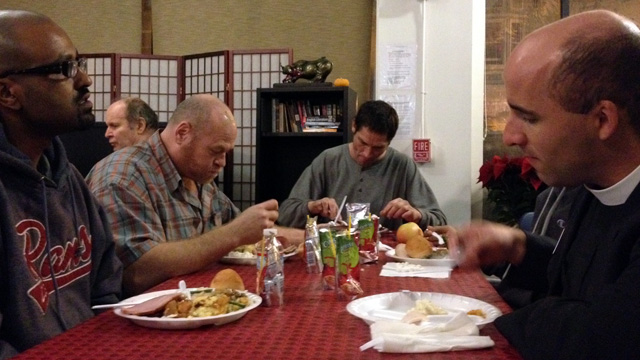“When I first moved here I really struggled with seeing people on the streets,” Sroka says. “I was tossing out granola bars on my way to work and being approached every day, and I didn’t know how to deal with it.”
Then she joined Grace Cathedral and learned about Dinner with Grace. Two teams of volunteers serve two different SROs.
One Tuesday, a team cooks. The next day they serve and eat the food with SRO residents, whose small rooms lack kitchens which make communal dining rare.
The Rev. Andy Lobban from Grace Cathedral oversees the program.
Lobban says what’s unusual about the program is that it’s “Dinner with Grace,” not “Dinner from Grace”. The team doesn’t just make the meal, they sit down with those they’re serving. That sets it apart from the typical soup kitchen.
“Perhaps [that model] is a little bit more efficient, but I find we gain more than we lose by taking it a little slower and taking the time to sit down at the table and cooking a little extra food so that volunteers can eat with the residents at the SROs,” Lobban says.
Residents like Troy Adams. The night after the cooking party, Adams is at the Crosby Hotel helping ferry 21 trays of food inside on a small gray cart.
“I just like to help out a little bit,” Adams says. “Get it done neat and organized. I like neat and I like organized.”
The Crosby’s residents include the formerly homeless subsidized by social programs, while others on limited incomes pay out of pocket. The average rent is $500 a month.
Tonight, about 70 residents crowd into the front lobby around tables decorated with small flower arrangements in plastic cups. Some write notes about what they’re thankful for as volunteers plate the food and start bringing it out.
At one table, Lobban asks participants: “What’s the most interesting thing that happened to you this week?”
A man named Gideon Borrou chimes in. “I think the most interesting for me was rain, finally, right?”
Borrou is a regular at the meals. He attends classes at City College of San Francisco and has lived at the Crosby ever since lodging with a relative fell through three years ago.
“When they have dinners like this, you get an hour to an hour and a half to sit down and discuss things and generally get an idea where people are,” Borrou says. “I’m the type of person who likes a community, it makes me happy.”
At the next table over, Jathaporn Chaloeitheep is scooping up forkfuls of turkey and yams. She says she was homeless for 10 years until she came here a month ago.
“This is the first time, this transition, trying to see if it works or not,” Chaloeitheep says. “You know, I’m trying to get back to the swing of things… like, part of the society versus being an outcast or being out there in the field.”
She says the two meals she’s eaten from Dinner with Grace beat the hot dogs she’d usually just heat up in her room. Plus, there’s the camaraderie among residents — and with volunteers.
Next to her a volunteer and two long-time residents, including Kate Rabbit, are debating the merits of running for exercise. Soon the conversation turns to food.
“I like having the one Thanksgiving meal, or that one Christmas meal. You know I’m OK with one. This was the one,” Rabbit says.
Before long everyone is headed off to their rooms. The volunteers remain around the pile of notes where the diners had written their thanks and started reading them aloud.
Some of the notes spoke of joys: “I’m thankful for health and life.” “Having a granddaughter on the way.”
Some were playful. Like the slip of paper that made everyone chuckle: “I’m thankful for soft toilet tissue.”
And many were poignant. “I am thankful for human kindness,” read one. And “Thank you Lord for a place to lay my head after two years of homelessness.”
As the volunteers gather to say goodbye, Sroka says so many pieces come together to make the meals happen. There are all of the volunteers who shop, those who cook. And then there’s the act of bringing people from such different backgrounds together around the table.
Sroka takes the opportunity to reflect. “Somehow it all works out, right?” she says with a relieved laugh.
That’s something in life we can all hope, and be thankful, for.

